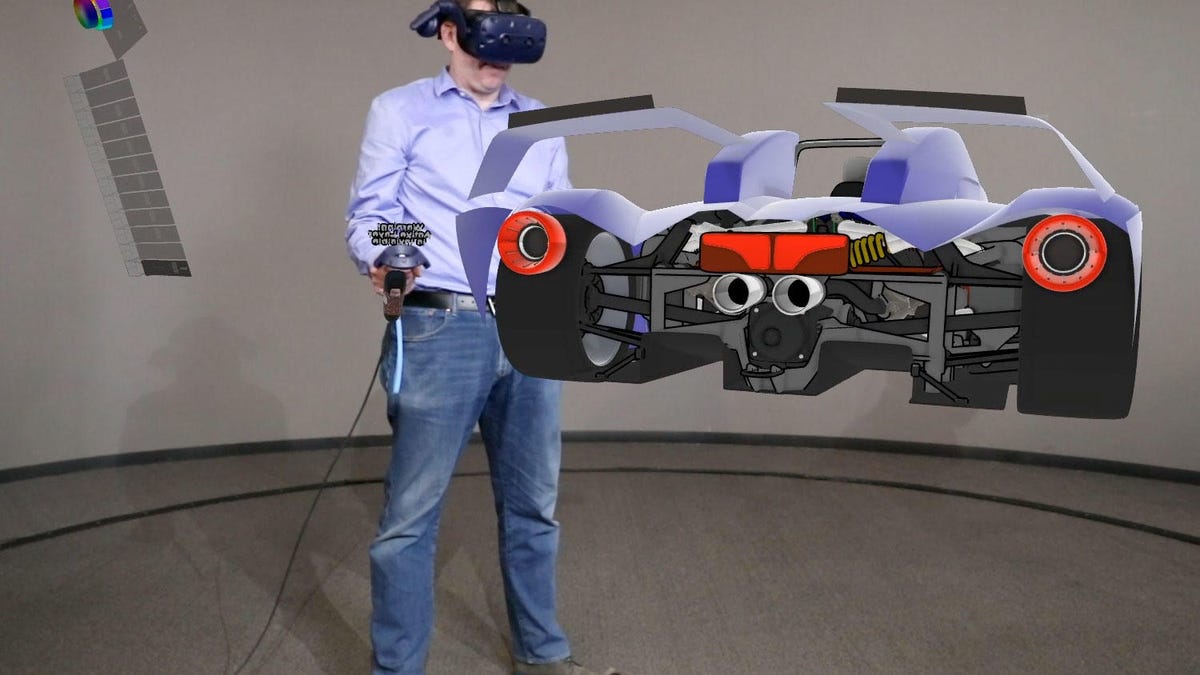Ford's designers are learning to create 3D cars in virtual reality
VR software Gravity Sketch allows a faster way to sketch cars.

Ford design manager Michael Smith is showing off a 3D rendering of a wild racing car concept. It has a fully realized exterior and interior, as well as incredibly detailed mechanical components: pushrod-style suspension, a hybrid powertrain and even details like intercoolers and turbocharger piping. Smith even overlaid some basic lines to experiment with aerodynamic airflow. (The car, I should note, is absolutely not intended for production.)
Smith says it took him about 40 hours of work in a virtual reality program called Gravity Sketch to create the vehicle rendering from scratch. How long would it have taken to produce something like this using Ford's traditional design methods, like 2D sketches and CAD software?
"We're talking months," he says at a presentation to journalists in Dearborn, Michigan last week. "If you wanted to make an interior and an exterior, you're still talking months," versus approximately 20 hours in the VR tool, he says.
Ford's Michael Smith walks me through some simple Gravity Sketch exercises.
About 40 to 50 Ford employees worldwide are currently experimenting with the idea of using Gravity Sketch to design future vehicles. They strap on a headset, grab a controller in each hand, and start "drawing" and shaping lines, curves and surfaces in the immersive digital environment. Gravity Sketch is a publicly available software package, using the HTC Vive virtual-reality headset, though Ford has worked with the software maker to customize it.
"Now we have a Ford version, and there's specificity and things that we've tweaked to make it more appropriate, and cooler, for us to use," he says.
Smith was playing with a VR painting app called Tilt Brush at home in his free time, when he stumbled on a beta version of Gravity Sketch. With its more advanced editing and creation functions, Smith saw its potential and, in early 2017, got Ford on board to begin experimenting with the software officially.
The advantages of designing a car -- or even just components of a car -- in VR are myriad, Smith says, and all help accelerate the process. He and his designers can create complex curves, they can "see" how a car looks from multiple angles and they can manipulate shapes in ways that weren't possible with old-school techniques like, say, clay modeling.
"I can do things I can't do in real life," he says. "I can be sitting in the model and have my head sticking through the surface, and I can be be gun-sighting a line."
Smith walks me through some demos to teach me how to use some basic functions of Gravity Sketch. Headset on, I'm immediately drawn into a white-walled virtual room. I can "see" tools that correspond to the controllers I'm holding. I can pull a trigger to start drawing a line, for instance, or use a directional pad to pick from a color wheel. Squeezing the left-hand controller and moving it in and out allows me to "zoom" in and out of my 3D surroundings. That can be used mid-design for "real-time evaluation at any angle, at any scale," Smith says.
"Drawing" lines and shapes in virtual reality.
My artistic skills extend to about fourth-grade line drawing, but it's still remarkably easy for me to pick up the basic Gravity Sketch tools. I write my name on a line, then walk around to the side and see that my signature floats in three dimensions. Another tool allows for automatically creating complex, interlocking curves in space. Those curves can be edited and tweaked later. A surfacing tool allows for "wrapping" surfaces over the outline of a car hood. And in another demo, I stand in the virtual driver's seat of a car cockpit while placing components -- a touchscreen, vents, the steering wheel -- where I'd like to have them arrayed around me.
It's easy to see how playing around in the environment could become addictive. Smith agrees, noting how immersed he became in designing that concept car: "Making myself really tiny to make the attachments for the intercooler connector... I just didn't want to stop, I was really having fun."
Smith says that it generally takes about eight hours of training for Ford designers to get up to speed with Gravity Sketch, and he notes that some younger designers are already learning some VR tools in design schools. The system can also be fully integrated with any of Ford's other design methods: importing sketches, exporting to CAD files and so on.
We'll have to wait a little longer to learn exactly when and how Ford plans to use Gravity Sketch for designing actual production models. But it's clear that Smith wants to accelerate use of the virtual reality techniques as soon as is feasible.
"Think of this as prototypical of how we might operate in the future," he says.
Virtual reality: CNET's coverage of the fast-evolving medium.
Ford: All the news out of Dearborn.

